Features
Nero Must Die! The Lost Potential of Devil May Cry 4

Devil May Cry 4 Retrospective
Although Devil May Cry 3 wasn’t nearly as much of a commercial success as the original or even Devil May Cry 2 for that matter, it still managed to repair the series’ image completely, if not actually bolster it. Hideaki Itsuno had saved Devil May Cry and Capcom was now in possession of a legitimate powerhouse franchise with a competent team at the helm. On a conceptual level, Devil May Cry 4 could not fail. Of course, that’s just conceptually. Devil May Cry 4 will forever be a reminder of the dangers of rushing a product for release. Not because it’s a bad game, but because it very easily could have been the greatest entry in the series.
For its first eleven missions, Devil May Cry 4 is a well paced, well designed, and surprisingly well-written evolution of Devil May Cry 3. Nero’s pull and grab playstyle gives the series maneuverability that simply wasn’t present in previous titles; missions are noticeably more complex with an emphasis on platforming and puzzle solving; and the story takes a more active, layered role with clear cut arcs and themes. There’s also a noticeable spike in the writing quality coming from the previous game. While Devil May Cry 4 is just as corny as Devil May Cry 3 when it comes to dialogue, it nails its more down to earth moments with greater consistency than its predecessor in large part thanks to Nero’s preestablished relationship with Kyrie.
A romance plot played straight in Devil May Cry almost feels blasphemous with how out of place it feels with the rest of the series’ aesthetic, but the level of care put into Nero’s and Kyrie’s dynamic does quite a bit of good for the game’s narrative. As Nero’s last few missions will have him directly trying to rescue Kyrie, it’s important to establish their connection early. Nero spends the entirety of the opening cutscene rushing through the streets of Fortuna, mowing down all enemies in his path, just so he can get to his girlfriend’s recital in time. It’s a goofy premise, but it’s one that can easily endear an audience to a character. The premise is pushed even further when Nero pretends to ignore Kyrie by listening to music after he gives her a necklace at the end of the performance. Nero is all of Dante’s dorkiness without the appropriate bravado to back it up. He’s so far away from being charming that it swings all the way back around and makes it endearing.
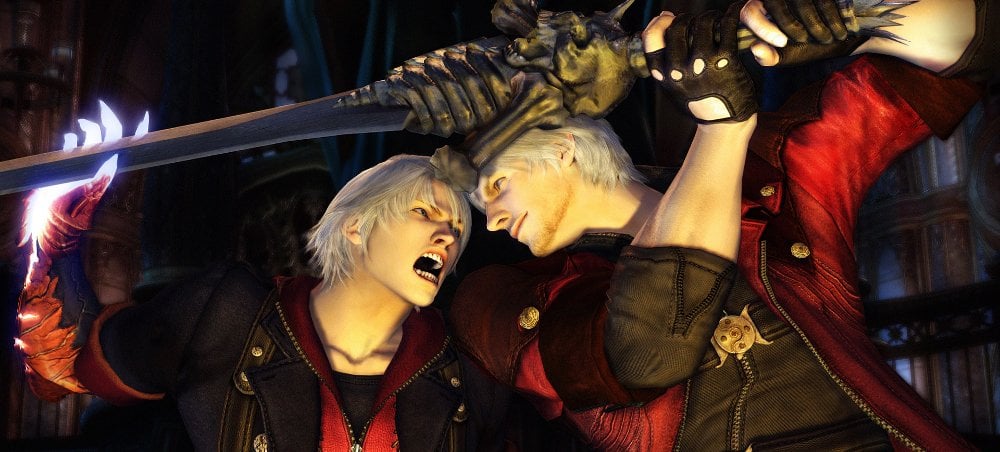
It certainly helps that Johnny Yong Bosch is easily the best voice actor in all of Devil May Cry. While Reuben Langdon consistently delivers a great performance as Dante, Bosch is on another level entirely, giving Nero a range of emotional depth other characters in the series struggle to attain. It really is easy to overlook just how well crafted Nero is due to how much he resembles Dante at first glance. He has white hair, they have similar builds, and his quips wouldn’t feel out of place coming out of DMC3 Dante’s mouth. On a conceptual level, Nero is a long-time fan’s worst fan: a watered-down, almost edgy, replacement for a well-liked protagonist. He isn’t watered down, though, or even edgy. He’s aesthetically similar to Dante, but the two couldn’t be better foils if Nero was Vergil himself.
To the script’s credit, Nero is never portrayed as “better” than Dante. Nero loses both their fights, fails to finish off a single boss properly, doesn’t gain a single boss weapon, and can’t maintain a full Devil Trigger. These “failings” keep Nero a grounded character while preserving Dante’s legacy. He struggles throughout the whole game in a way that Dante never has. This is an important distinction since it’s easier to warm up to a new character when they have to earn their keep. Both through the gameplay and narrative, Nero proves himself a potentially worthy successor to Dante without ever showing him up. Nero’s arc is inherently about struggle. Specifically, the struggle to accept his demonic heritage framed through the physical manifestation of his Devil Bringer. When he finally comes to terms with it at the end of the game, it makes sense because audiences have seen Nero struggle with the demonic on an internal and external level for the majority of Devil May Cry 4. With a clear personality and arc backed by a script that goes to lengths to ensure Nero is treated how he should be in the context of the DMC universe, Devil May Cry 4 molds a main character who can more than make up for the loss of Dante.

All that said, Devil May Cry is not a series that fans come to for the story. This is a series that prioritizes gameplay first, and the only way Nero was truly going to win over fans was by proving his worth from a combat sense. Nero’s style of play is arguably the most engaging and skill-based in the entire franchise. Every new mechanics Nero brings to the table is fully realized, given a considerable amount of depth, and polished to the point of gameplay perfection. Nero doesn’t make use of weapon switching as Dante does, but he doesn’t need to. Every weapon Nero has is versatile enough where any additions would have simply bogged him down. While the level of customization Devil May Cry 3 introduced for Dante was absolutely a positive, giving the gameplay added depth, it is refreshing that Itsuno chose a more focused approach for Nero.
The biggest of Nero’s gameplay additions, and the only one that didn’t already have a basis in the series prior to Devil May Cry 4, is his Devil Bringer. From a distance, Nero can pull enemies toward him to keep combos active in one static location. Although novel enough for grounded combat, it’s mid-air where the Devil Bringer truly shines. In combination with Nero’s air-based attacks, it’s theoretically possible to keep Nero in the air indefinitely so long as there are enemies on the screen. It’s this inherent verticality that Nero has that separates him from Dante in gameplay. Being able to juggle enemies in the air, and stay in the air, isn’t necessarily a logical evolution of Devil May Cry’s combat, but it’s one that opens up the action immensely. Nero’s Devil Bringer adds an unprecedented layer to the combat giving fights more variety than ever.
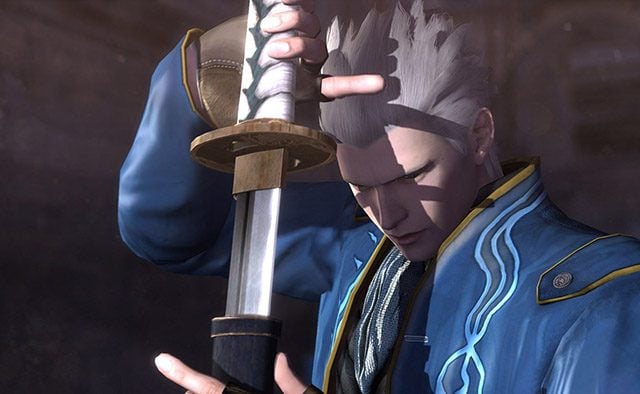
To play off of Nero’s verticality, enemies are designed to take flight more often than in previous games. Many of DMC4’s new foes have techniques that keep them in the air for long periods of time, emphasizing the importance of Devil Bringer. There are even some enemies that Nero pulls himself towards, rather than the other way around, ensuring Devil Bringer isn’t just a static technique. To go along with DB’s variety dependent on the enemies, Nero has a Buster attack where he can grab an enemy and launch into a unique animation so long as he’s not locked onto them when using Devil Bringer. In a way, Devil Bringer can be used to parry attacks and counter enemies. There are no button prompts to signify when to counter so it’s on the onus of the player to pay attention to enemy and boss animations in order to properly make use of Devil Bringer’s innate ability to counter attacks.
Outside of Devil Bringer, Nero’s main weapons are Red Queen and Blue Rose, a sword and gun combo expected of a Devil May Cry protagonist. Red Queen and Blue Rose are vastly different from Dante’s Rebellion and Ebony & Ivory, however. While both weapons can be used in their traditional manner—pause combos and directional inputs for Red Queen, juggling purposes and Style management for Blue Rose—Nero has a charge up system in place where his sword and gun can, and should, be charged up during the midst of battle so they can be made use of properly. In and out of combat, Nero can use an ability Exceed that revs up Red Queen and levels it up temporarily. Attacking with a revved-up Red Queen resets its level back down, but connecting an attack ends up doing an enormous amount of damage. The trick behind Exceed, though, is that it’s timing-based, and best utilized during the heat of combat. It’s another element of reflex-based gameplay in a game that’s already demanding one’s reflexes, but it’s one absolutely worth mastering. A fully upgraded, well-timed Exceed will level Red Queen up to max immediately, making it a valuable skill to have on higher difficulties.
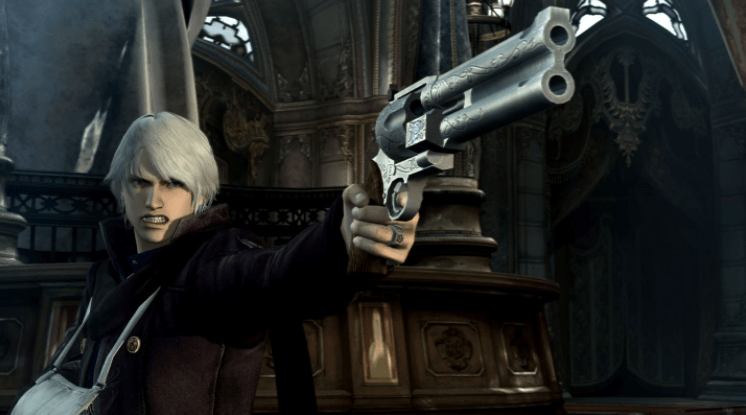
Blue Rose’s charge isn’t nearly as in-depth or demanding as Red Queen’s, but it still requires a fair amount of skill to utilize properly. During combat, Nero can charge up Blue Rose up to three separate tiers and then release it for a massive burst of damage. The trouble with using Blue Rose properly though comes from the multitasking it adds to the combat. In a vacuum, it’s deceptively simple in concept and execution, but in the heat of the moment, it’s another layer to an already layered experience. In many ways, that’s the best part of Devil May Cry 4’s design. It derives its complexity not from convoluted mechanics, but by how it implements several easy to understand concepts into the combat. Individually, each new reflex-based command is easy enough to use. Put together, they chain into complex combos that require legitimate skill to pull off properly.
This is to say nothing of the way Nero’s Devil Trigger effects combat. Although it serves the same base purposes, as usual, Nero’s Devil Trigger is less a full-on demonic power up as it is a way of using Yamato, Vergil’s signature katana. In his DT state, Nero doesn’t transform but instead summons a spirit who wields Yamato in conjunction with Nero’s Red Queen. Yamato also greatly enhances Devil Bringer, giving it the ability to pull multiple enemies at once, and adds Vergil’s signature Summon Swords to Blue Rose’s basic shot. It’s an unorthodox approach to Devil Trigger, but it’s one that makes sense for both Nero and the overall gameplay. It’s a stylistically cool design choice and one that fits the image the series built for itself over the past three games.
With a great script and even better combat system, Devil May Cry 4 establishes itself quite well right out the gate. Good gameplay means little without good level design, though. DMC4 features the best mechanics in the series, but how does the game actually take advantage of that fact? For the first eleven missions, fairly well. Nero’s portion of Devil May Cry 4 has the best pacing in the series. On a narrative level, each mission ensures Nero is making some degree of significant progress, with the plot moving at a steady pace. On a gameplay level, there’s seldom a mission that doesn’t give Nero a new ability, whether it just be one that works in regards to puzzle-solving, or pit him against a boss. Progress is felt on every front, and there’s little to no wasted space in the actual game design.

Nero’s first mission has him fighting Dante, a fantastic start that adds intrigue to the plot immediately while also offering a genuinely surprising introduction for fans; the second mission is a lengthy, traditional stage that takes advantage of Nero’s Devil Bringer along the way and ends with a boss fight; the third mission is a standard stage that evokes DMC1’s castle imagery and leads up to Nero obtaining a new item; mission four ends with yet another boss fight; the fifth mission has Nero exploring the rest of the castle with some light puzzle-solving; mission six has a boss fight halfway through, and then continues as a regular stage, a first for the series; and missions seven through eleven all culminate in boss fights with the last few stages featuring some of the best bosses and set pieces in the game. There’s only one problem with Nero’s section of Devil May Cry 4: it ends.
The moment mission eleven comes to an end is the moment Devil May Cry 4 begins to fall apart. That’s not to say it’s without merit, Dante is at his absolute best gameplay and personality-wise in his seven missions, but everything that defined DMC4 up to that point goes missing. The story takes a nosedive, meandering for the rest of the game; Dante simply backtracks through Nero’s stages with a few new gimmicks thrown into the mix; the game as a whole just feels like it was designed more with Nero in mind rather than an equal compromise where Dante transitions in seamlessly. There’s no gameplay situation that Dante can’t handle himself, but there are instances that remind audiences that Devil May Cry 4 was Nero’s game, not Dante’s.
The situation is made all the more disappointing due to just how outstanding Dante is from a mechanical standpoint. He can switch his Style on the fly and can have six weapons equipped at all times leading to some of the most engaging combat in the franchise. DMC4 Dante takes Devil May Cry 3’s base and outright masters it. If Nero’s main combat gimmick is verticality, Dante’s is just sheer variety. So why is it disappointing? Because Dante deserves better in this state. A character this mechanically refined shouldn’t be backtracking through stages blatantly designed for another character, he should have his own set of missions where his playstyle can truly shine.
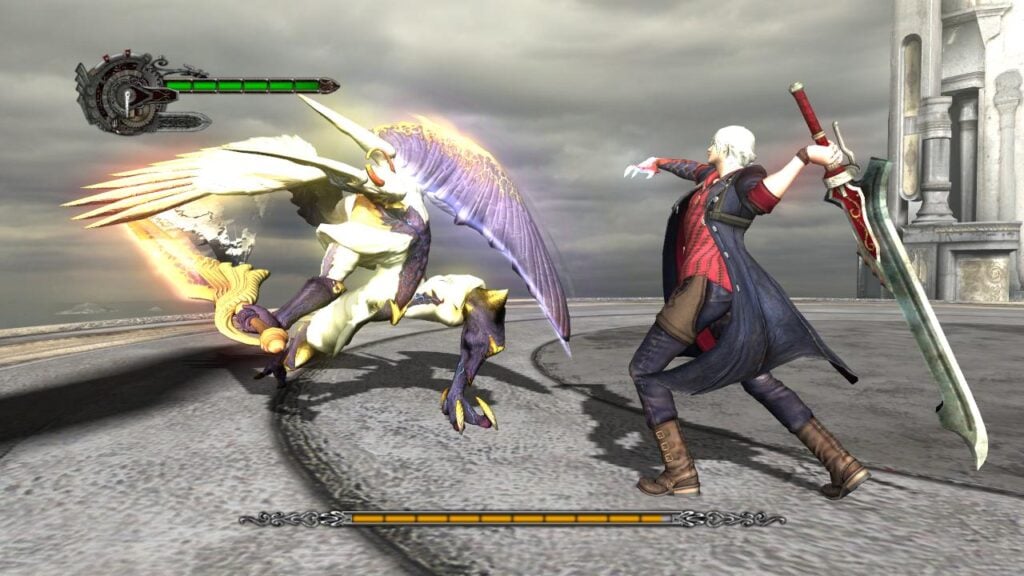
This is to say nothing of the fact that Dante’s weapons don’t share the names of the bosses he finishes off. As Devil May Cry 3 establishes explicitly, bosses that turn into weapons keep their namesake. The three-headed Cerberus becomes the nunchaku “Cerberus,” the kickboxing Beowulf becomes the gauntlets “Beowulf,” and so on and so forth. This is a trend that Devil May Cry 4 drops entirely. Even the Devil Arms Dante gets from the bosses don’t resemble them. Gilgamesh has absolutely no connection to Echidna and Lucifer couldn’t be further from Belial. While it makes sense why Dante would finish off Nero’s bosses, both from a narrative and gameplay perspective, knowing he was originally slated to have his own set of bosses just sours the experience all the more.
As sad as it is to see the level design take an enormous hit in the character shift to Dante, it is still possible to have fun in the second half thanks to just how mechanically sound he is as a character. It doesn’t excuse missions twelve through eighteen, not in the slightest, but it does keep them from being outright bad. What can’t be salvaged by Dante, however, is the story. Even though Devil May Cry is not a plot-driven series, Devil May Cry 4’s narrative was doing a great job at fleshing out the universe, developing Nero, and actively moving toward a climax. With Dante at the helm and a fully developed one at that, all that’s there for him to do is rescue Nero. There is a progression building up to control switching back to Nero, but it doesn’t feel as deliberate or as smooth as all the build-up done in the first half.
It’s hard to believe Itsuno and his team would mess up this badly after clearly learning from their mistakes during Devil May Cry 3’s development. DMC3 wasn’t just an improvement from Devil May Cry 2, it was the logical next step in the franchise’s evolution. Nero’s first eleven missions, and Dante’s playstyle, seem to imply that Devil May Cry 4 was meant to follow that same design philosophy, but something clearly went wrong along the way. The only logical explanation is that, following the lucrative critical success of Devil May Cry 3, Capcom rushed Devil May Cry 4 out the gate to capitalize on the franchise’s newfound goodwill. In very few ways should DMC4’s shortcomings be associated with the development team. Along with following a title that was quickly establishing a legacy as one of the greatest games of all time, Itsuno and his team were working with new hardware. All things considered, Devil May Cry transitioned magnificently from the PlayStation 2 onto the PlayStation 3 and Xbox 360.
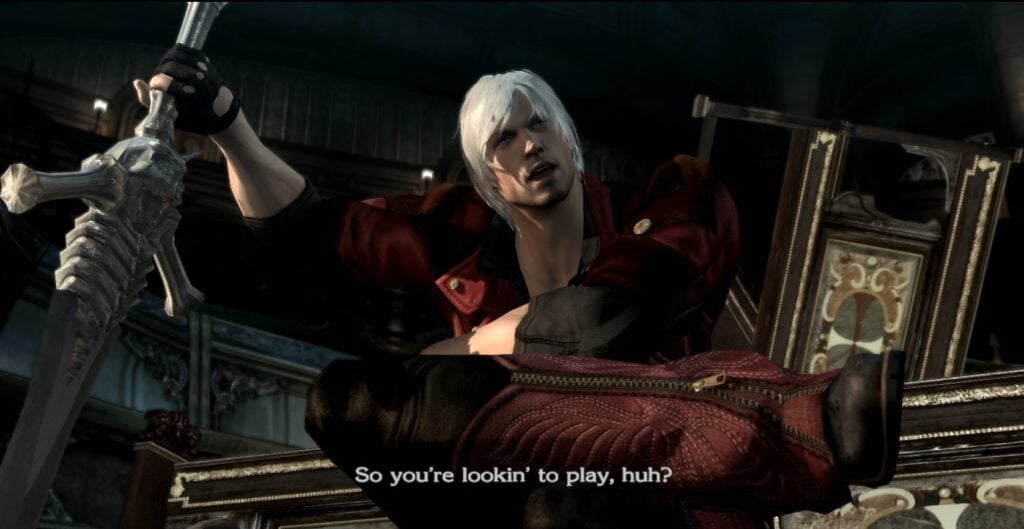
On just a conceptual level, all the ideas in place make sense. Of course Dante would take over as the main character at some point and of course, control would go back to Nero for the finale. That’s not the problem. The problem is that it’s obvious the dev team didn’t have time to flesh out Dante’s section before release. It’s fine that Dante fights the same bosses as Nero, that was a trend that was established all the way back in the original Devil May Cry, but it’s not fine to have Dante just play through the same stages, except in reverse. Backtracking is not inherently bad despite the negative reputation it tends to get, but it isn’t handled well in Devil May Cry 4, because there was no way it could be handled well in a scenario where it was rushed for release.
Devil May Cry 4 is a series that demands a level of care and attention to detail to work. It needs to be treated with respect from a development standpoint which Capcom clearly did not care to do. DMC4 simply cements Devil May Cry as a series plagued by developmental issues. The original Devil May Cry began development as Resident Evil 4; Devil May Cry 2 wasn’t even a Devil May Cry game originally and Itsuno was brought on too late to save the project; Devil May Cry 4 was rushed at what seems like only halfway through development. That’s what stings most. Had DMC4 been rushed near the end of its natural cycle, it would have been disappointing, but it would have yielded are far better result with a Dante campaign that potentially felt wholly unique. As it is, Capcom pulled the trigger on the project far too early resulting in a well produced and designed first half followed by a haphazard second half with an identity crisis.
Even Devil May Cry 4: Special Edition, which had the perfect platform to fix DMC4’s issues, squanders its chance by simply adding new playable characters into the mix. Granted, Vergil, Lady, and Trish all play phenomenally and were clearly crafted with a level of care, but Special Edition nonetheless doesn’t fix DMC4 outside of a few balancing tweaks. Regardless, whether one plays Special Edition or the original release doesn’t matter, as both are just different versions of the same incomplete game. Does this mean Devil May Cry 4 is bad or not worth playing? Not even close. DMC4 is the gold standard when it comes to combat in the genre and Nero’s first eleven missions are proof that DMC can still evolve in a tasteful, exciting manner. DMC4 is disappointing, but disappointment isn’t an outright absence of quality. In many cases, disappointment comes from the fact that quality is present, just not properly utilized. Devil May Cry 4 is a good game that very easily could have been amazing had its potential not been robbed by a rushed release date.

-

 Features4 weeks ago
Features4 weeks agoDon’t Watch These 5 Fantasy Anime… Unless You Want to Be Obsessed
-

 Culture3 weeks ago
Culture3 weeks agoMultiplayer Online Gaming Communities Connect Players Across International Borders
-

 Features3 weeks ago
Features3 weeks ago“Even if it’s used a little, it’s fine”: Demon Slayer Star Shrugs Off AI Threat
-
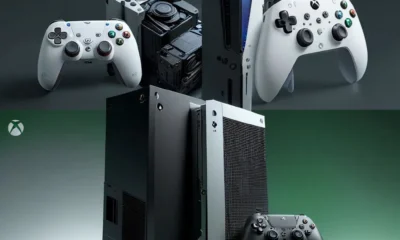
 Features2 weeks ago
Features2 weeks agoBest Cross-Platform Games for PC, PS5, Xbox, and Switch
-

 Game Reviews4 weeks ago
Game Reviews4 weeks agoHow Overcooked! 2 Made Ruining Friendships Fun
-

 Features3 weeks ago
Features3 weeks ago8 Video Games That Gradually Get Harder
-

 Game Reviews4 weeks ago
Game Reviews4 weeks agoHow Persona 5 Royal Critiques the Cult of Success
-
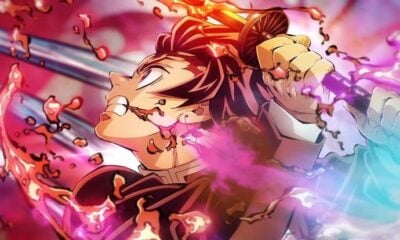
 Features2 weeks ago
Features2 weeks agoThe End Is Near! Demon Slayer’s Final Arc Trailer Hints at a Battle of Legends
-
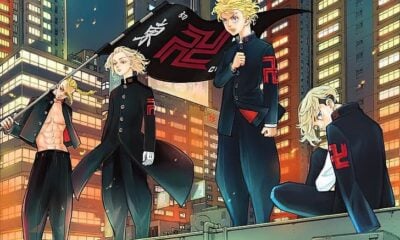
 Features2 weeks ago
Features2 weeks agoDon’t Miss This: Tokyo Revengers’ ‘Three Titans’ Arc Is What Fans Have Waited For!
-
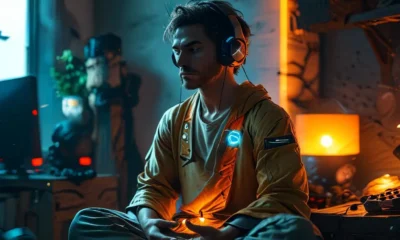
 Uncategorized3 weeks ago
Uncategorized3 weeks agoSleep Meditation Music: The Key to Unwinding
-
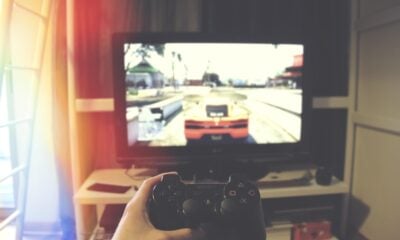
 Guides2 weeks ago
Guides2 weeks agoHow to buy games on Steam without a credit card
-
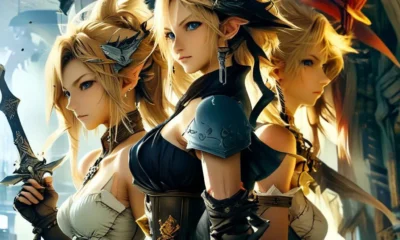
 Game Reviews2 weeks ago
Game Reviews2 weeks agoFinal Fantasy VII Rebirth Review: A Worthy Successor?






















